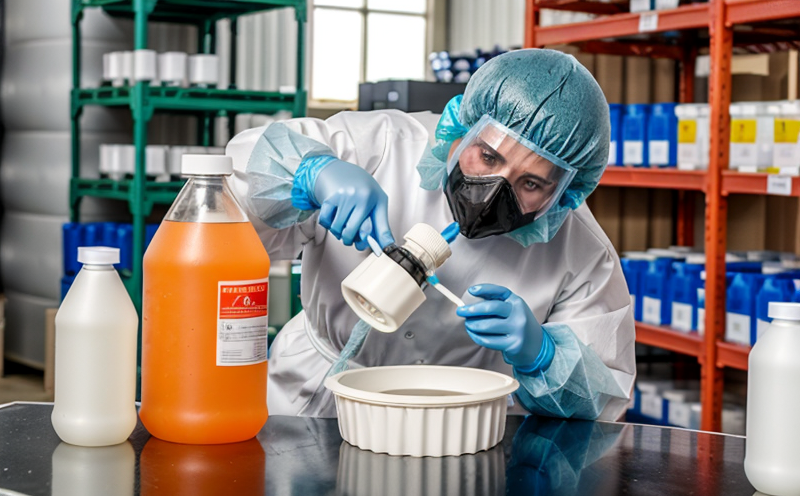ISO 21150 Detection of E. coli in Packaging Materials
The ISO 21150 standard is pivotal in ensuring that packaging materials do not inadvertently contaminate food products with harmful bacteria, particularly E. coli O157:H7. This standard provides a method for detecting the presence of this specific strain using membrane filtration and immunomagnetic separation techniques followed by polymerase chain reaction (PCR) analysis.
This service is critical in sectors where food safety and hygiene are paramount, such as pharmaceuticals, cosmetics, and food processing. Packaging materials like plastic films, paperboards, cartons, and metal cans must be rigorously tested to prevent cross-contamination during storage or transport. The process involves the collection of samples from packaging materials, followed by a series of steps that ensure accurate detection.
The first step in this process is the preparation of the sample using membrane filtration. This technique allows for the concentration and separation of potential pathogens from large volumes of liquid or solid samples. Once concentrated, the sample undergoes immunomagnetic separation to isolate E. coli O157:H7 from other microorganisms.
The isolated organisms are then subjected to PCR analysis, which amplifies specific genetic material unique to this strain. The presence of the target DNA indicates that E. coli O157:H7 is present in the packaging materials, necessitating further investigation and potential reprocessing or replacement.
This service not only ensures compliance with international standards but also enhances consumer safety by preventing potentially harmful bacteria from reaching the final product. The accuracy of this method is critical given that even a single contaminated unit can lead to widespread contamination if not detected early in the supply chain.
| Step | Description |
|---|---|
| Sample Collection | Collection of samples from packaging materials using appropriate sampling techniques. |
| Membrane Filtration | Concentration and separation of potential pathogens for easier detection. |
| Immunomagnetic Separation | Isolation of E. coli O157:H7 from other microorganisms in the sample. |
| PCR Analysis | Detection and confirmation of E. coli O157:H7 through genetic material amplification. |
The ISO 21150 method is widely recognized for its high sensitivity, specificity, and reproducibility, making it a preferred choice among regulatory bodies and industry professionals. This service ensures that packaging materials meet strict hygiene standards, thereby protecting the integrity of food products.
Benefits
The implementation of ISO 21150 in detecting E. coli O157:H7 in packaging materials offers several significant benefits:
- Enhanced Consumer Safety: By ensuring that packaging materials are free from harmful bacteria, this service helps protect consumers from potential foodborne illnesses.
- Compliance with Regulations: This method ensures compliance with international standards such as ISO 21150 and local regulations, thereby reducing the risk of legal consequences.
- Improved Product Quality: Early detection allows for timely interventions, ensuring that only safe packaging materials reach the market.
- Increased Market Confidence: Companies that adhere to stringent hygiene standards are more likely to gain consumer trust and maintain a positive reputation in the marketplace.
In summary, this service not only meets regulatory requirements but also contributes significantly to safeguarding public health and maintaining product quality.
Industry Applications
| Industry | Application |
|---|---|
| Packaging & Packaging Materials | Detection of E. coli O157:H7 in packaging materials to ensure food safety. |
| Pharmaceuticals | Validation of hygiene measures in drug packaging to prevent contamination. |
| Cosmetics | Assessment of packaging materials used for storing and transporting cosmetics. |
| Food Processing | Testing of packaging materials in food processing plants to ensure hygiene standards. |
The ISO 21150 method is particularly vital for industries where the integrity and safety of products are paramount. By adhering to this standard, companies can demonstrate their commitment to quality control and consumer safety.
Environmental and Sustainability Contributions
The ISO 21150 method not only ensures product safety but also contributes positively to environmental sustainability in several ways:
- Reduced Waste: By ensuring that packaging materials are free from harmful bacteria, this service minimizes the risk of contamination during transport and storage.
- Saved Resources: Preventing cross-contamination reduces the need for reprocessing or replacing contaminated packaging, thereby saving raw materials and energy.
- Better Resource Allocation: Ensuring that only safe packaging reaches the market helps in more efficient resource allocation throughout the supply chain.
- Informed Decision-Making: Early detection allows companies to make informed decisions about their packaging processes, leading to more sustainable practices.
In conclusion, this service is not only a compliance measure but also an essential tool for promoting sustainability in the packaging and food processing industries.





